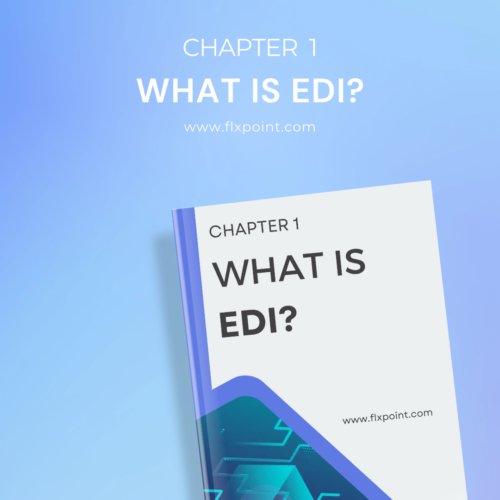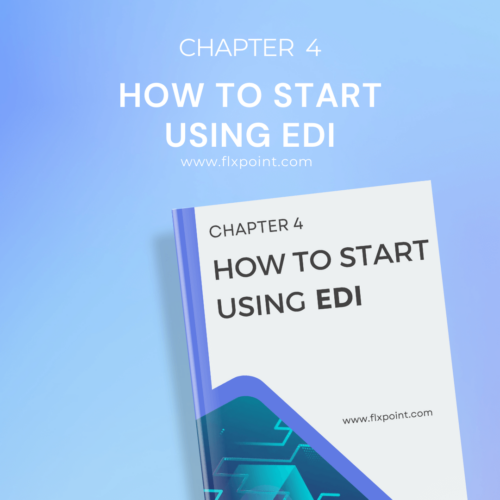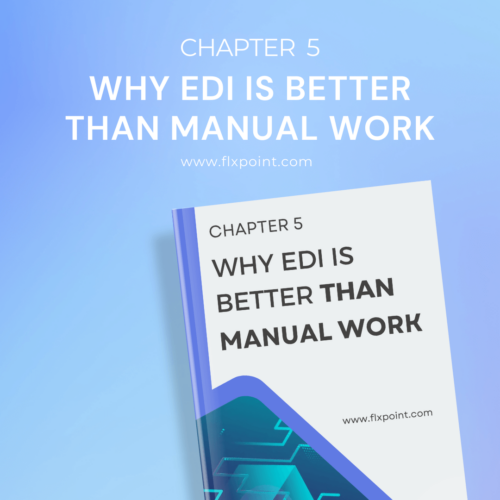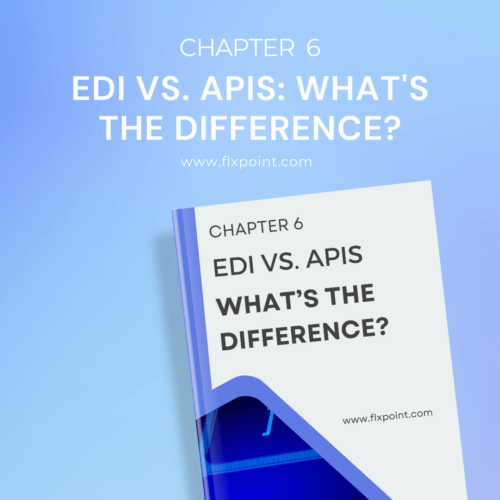Chapter 10 Quick Glossary of EDI Terms
This quick glossary defines key terms, making EDI concepts accessible and understandable for you.

Chapter 10: Quick Glossary of EDI Terms
A
ANX
ANX stands for Advanced Network Exchange. It is a secure network used for the electronic exchange of business documents, primarily in the automotive industry. ANX provides a platform for suppliers and manufacturers to share sensitive information while ensuring compliance with industry standards.
Abstract Data Type
An Abstract Data Type (ADT) is a mathematical model for data structures that defines a set of operations on data and the rules governing them without specifying their implementation details.
Accredited Standards Committee X12
The Accredited Standards Committee X12 (ASC X12) is a U.S.-based standards development organization responsible for creating and maintaining cross-industry electronic data interchange (EDI) standards.
ACK (Acknowledgment)
An ACK is a response sent to confirm the receipt of a message or transaction in EDI systems. It serves as a verification that data has been successfully received and, in some cases, processed, ensuring communication integrity between trading partners.
Active Tag
An Active Tag is a type of RFID (Radio Frequency Identification) tag that has its own power source, enabling it to transmit data over long distances. Unlike passive tags, which rely on external readers, active tags can send signals autonomously, offering greater range and functionality.
Advance Ship Notice (ASN)
An Advance Ship Notice (ASN) is an electronic document sent by a supplier to inform a buyer about the details of a shipment, including item quantities, packaging, and expected delivery time. It’s crucial for streamlining logistics, inventory management, and improving supply chain visibility.
AES: Advanced Encryption Standard
AES (Advanced Encryption Standard) is a symmetric encryption algorithm widely used to secure sensitive data. It operates on fixed-size blocks of data, using key sizes of 128, 192, or 256 bits, ensuring high security and efficiency in modern cryptography and data protection.
American National Standards Institute (ANSI)
ANSI is a private non-profit organization that oversees the development and implementation of voluntary consensus standards for products, services, processes, and systems in the United States. It plays a crucial role in the standardization of EDI formats and protocols.
ANA: Article Number Association
ANA refers to the standardized system used to assign unique identifiers to products or items within a catalog. This system ensures consistent referencing across supply chains, enhancing clarity and accuracy in inventory management and electronic data interchange (EDI) transactions.
ANSI ASC X12
ANSI ASC X12 is a widely used standard for Electronic Data Interchange (EDI) in North America. Developed by the Accredited Standards Committee (ASC) under the American National Standards Institute (ANSI), it defines the format and structure of electronic documents for business transactions.
API
An API is a set of rules that allows different software systems to communicate with each other. It defines the methods and data formats that applications use to request and exchange information.
Application Acknowledgment
An Application Acknowledgment is a message sent from the receiver’s system to confirm the successful receipt and processing of an electronic data interchange (EDI) message.
Application Advice
Application Advice refers to a type of EDI message that provides feedback on the processing of a transaction. This message indicates whether a transaction was accepted or rejected and may include reasons for any discrepancies, helping businesses rectify issues promptly.
Application Interface Software
The term “Application Interface Software” can refer to what is commonly known as an API (Application Programming Interface). Both terms describe the means by which different software applications or systems communicate with each other.
ALE
ALE is a middleware technology primarily used in SAP systems for integrating different applications. It facilitates the seamless exchange of data between heterogeneous systems within an enterprise. ALE supports distributed processing and allows for communication via message-based interfaces, ensuring the consistent flow of business transactions across diverse platforms.
AS1
AS1, or Applicability Statement 1, is a protocol designed to facilitate secure and reliable messaging for Electronic Data Interchange (EDI) over the internet using email-based transport, ensuring authentication, integrity, and non-repudiation.
AS2
AS2 uses HTTP/S for secure, real-time EDI exchanges. It offers faster, more reliable communication with encryption, authentication, and non-repudiation, optimizing high-volume transactions between trading partners.
AS3
AS3 (Applicability Statement 3) is a secure protocol for exchanging EDI documents using FTP/S instead of HTTP/S (AS2) or email (AS1), supporting batch processing and large file transfers.
AS4
AS4 (Applicability Statement 4) is a secure messaging protocol for exchanging EDI documents over the internet using web services. It offers improved interoperability, reliability, and flexibility compared to AS3, supporting both small and large-scale transactions with enhanced security features.
ASC X12
ASC X12 is a standardized electronic data interchange (EDI) format developed by the Accredited Standards Committee (ASC) X12. It facilitates the exchange of business data such as invoices, purchase orders, and shipping notices between organizations, ensuring consistency and automation in communication across industries.
ASN
An Autonomous System Number (ASN) is a unique identifier assigned to an autonomous system (AS) in IP networking. It allows routing protocols, like BGP, to distinguish between different networks and manage the flow of data across the internet.
Asynchronous
Asynchronous refers to processes or actions that occur independently of a set time frame or without needing to happen simultaneously. In computing, it describes operations that can execute without waiting for other tasks to finish, allowing for parallel execution and more efficient resource usage.
Attribute
An “attribute” refers to a characteristic or property that defines an object or entity within a system. It can describe qualities like size, color, or type in software, or features like memory capacity and processing speed in hardware.
Audit Trail
An audit trail in EDI (Electronic Data Interchange) refers to a chronological record of all data exchanges between parties. It provides transparency by tracking and documenting every transaction, ensuring accountability and enabling efficient error resolution, security, and compliance in business processes.
Authentication
Authentication is the process of verifying the identity of a user, system, or entity within an Electronic Data Interchange (EDI) environment. It ensures that only authorized parties can access and exchange sensitive data, typically through passwords, digital certificates, or biometric methods.
B
B2B
B2B (Business-to-Business) refers to transactions, interactions, and relationships between two businesses, rather than between a business and individual consumers.
BAI
BAI stands for Bank Administration Institute, a standard format used for the electronic transmission of financial data between businesses and banks.
Bar Code
A barcode is a visual representation of data that can be read by machines, typically scanners. It consists of a series of parallel lines, spaces, and sometimes additional characters, designed to encode information in a way that is easily interpreted by optical scanners.
Batch Control Totals
A Batch Control Total is a numerical figure (or set of figures) that is used to verify the integrity and completeness of a data batch as it is processed through various stages of a system. The totals provide a method to check whether the batch has been correctly processed without data loss or corruption.
Batch Processing
Batch processing is a method of executing tasks or jobs in groups without manual intervention, typically involving data collection, processing, and output generation according to predetermined schedules and instructions.
Baud
A unit measuring symbol transmission speed in data communications, representing the number of signal changes per second. Unlike bits per second, baud counts actual signal transitions regardless of information content.
Bill of Lading
A legal transport document serving as receipt of goods, contract of carriage, and document of title. In EDI, it’s transmitted as an electronic message (typically 856) between trading partners.
Binary
In EDI, binary format enables efficient data transmission and storage while maintaining data integrity during electronic exchanges.
Bisynchronous
A character-oriented data transmission protocol where both sender and receiver operate in synchronized timing. It uses specific control characters to maintain data synchronization during transmission.
Business Document
A structured electronic message containing specific business data exchanged between trading partners. It follows predetermined formats and standards to enable automated processing in EDI systems.
Business Partner
An entity involved in a business transaction or relationship, such as a supplier, customer, or service provider.
Business Partner Agreement
A formal contract defining technical and business rules for exchanges between partners, including protocols, standards, testing requirements, and legal responsibilities.
Business Process
A set of structured activities or tasks that produce a specific outcome, often automated or managed through technology, aimed at achieving business goals.
Business Process Modelling
The practice of representing and analyzing business processes to improve efficiency, often using flowcharts or software tools to visualize workflows.
Business Rules
Predefined conditions and logic governing EDI document processing, validation, and routing. They ensure transactions meet business requirements and compliance standards.
B2B Integration
The technological framework enabling automated exchange of business documents between different organizations’ systems using EDI and related protocols.
C
CEDI
CEDI stands for Centralized Electronic Data Interchange. It is a system that facilitates the electronic exchange of data between various trading partners, enhancing communication efficiency and reducing errors associated with manual data entry.
CEFACT
CEFACT refers to the United Nations Centre for Trade Facilitation and Electronic Business. This organization develops international standards and recommendations for electronic business transactions, promoting interoperability and efficiency in global trade.
CA
CA stands for Certificate Authority, an entity that issues digital certificates used to verify the identity of organizations in electronic transactions. CAs play a crucial role in ensuring secure communications over networks by establishing trust between parties.
CRL
CRL is short for Certificate Revocation List. It is a list maintained by a Certificate Authority that contains the serial numbers of digital certificates that have been revoked before their scheduled expiration date, ensuring that only valid certificates are used in transactions.
Classifier
An EDI Classifier is a system or tool used to categorize and organize electronic data interchange (EDI) transactions. It helps identify, validate, and map incoming or outgoing EDI messages to the correct business processes, ensuring data is routed appropriately within automated workflows.
Clearing House
An intermediary organization that processes and routes Electronic Data Interchange (EDI) transactions between trading partners, ensuring accurate format and compliance before forwarding data. It acts as a bridge between senders and receivers.
Communication Software
Communication Software refers to programs or systems that enable the exchange of data between computers or devices over a network.
Communications
The electronic exchange of data between EDI systems via protocols like AS2, SFTP, or VANs (Value-Added Networks), ensuring secure, reliable, and standardized data transmission.
Compliance Checking
Compliance Checking ensures that EDI transactions comply with ANSI X12 syntax rules, which govern the structure and formatting of data exchanged in electronic transactions.
Compliance Testing
Compliance testing refers to the process of verifying that a system or application meets specified standards and regulations. This ensures that all components function as intended and adhere to legal and industry requirements.
Conditional
In EDI terminology, conditional denotes a requirement that must be met for a specific action to occur. It is often used to describe data elements or segments that are only necessary under certain circumstances.
Confirmation
Confirmation in EDI refers to an acknowledgment message sent by one trading partner to another, indicating receipt of an EDI document. This ensures that both parties are aware of the transaction’s status and can proceed accordingly.
Consumer Packaged Goods
Consumer Packaged Goods (CPG) are products sold quickly at relatively low cost, such as food, beverages, toiletries, and other consumables. The CPG industry heavily relies on EDI for efficient supply chain management and inventory control.
Continuous Replenishment Program
A supply chain strategy aimed at maintaining optimal inventory levels by automatically replenishing stock based on real-time sales data and demand forecasts.
CONTRL
CONTRL is an EDI message type used to confirm the successful processing of other EDI messages. It serves as a control envelope that contains information about the status of transmitted messages, helping ensure data integrity throughout the exchange process.
Control Envelope
A Control Envelope is a wrapper around EDI messages that contains metadata about the transmission, such as sender and receiver information, message type, and control numbers. This envelope helps manage and track EDI communications effectively.
Control Number
The Control Number is a unique identifier assigned to each EDI transaction set or message. This number aids in tracking and referencing specific transactions within the EDI system, ensuring accurate record-keeping and retrieval.
Control Segment
A Control Segment is a part of an EDI message that contains control information necessary for processing the message. It typically includes details like transaction set identifiers and control numbers, facilitating proper handling by receiving systems.
Control Structure
The Control Structure refers to the organizational framework of an EDI message, detailing how segments are arranged and how data elements are grouped. This structure ensures consistency in data exchange across different trading partners.
Control Validation
Control Validation involves verifying the accuracy and completeness of control segments within an EDI message. This process ensures that all necessary information is present before processing transactions, reducing errors in data exchange.
CPFR
CPFR, or Collaborative Planning, Forecasting, and Replenishment, is a business practice where trading partners collaborate on planning and inventory management to improve supply chain efficiency. It enhances demand forecasting accuracy through shared insights.
CXML
CXML, or Commerce XML, is an XML-based protocol designed for e-commerce transactions. It enables seamless communication between buyers and suppliers by standardizing purchase orders, invoices, and other procurement documents in a machine-readable format.
D
Data Element
A data element in EDI is the fundamental unit of data within a message, categorized as simple or composite, and defined by its optionality (mandatory, optional, or conditional) and separators.
Data Element, Composite
A group of related data elements combined into a single structure within EDI messages, representing a logical unit of information, like an address or product details.
Data Integrity
The assurance that electronic data remains complete, accurate, and unaltered during transmission and storage. It ensures that the information maintains its original content and format from sender to receiver without any unauthorized modifications.
Data Mapping
The process of establishing relationships between data elements across different EDI formats or systems. It defines how fields from one document format correspond to fields in another, enabling accurate translation between trading partners.
Data Pool
A centralized repository that stores and maintains standardized product information and trading partner data. It serves as a synchronized database where multiple parties can access, update, and share consistent business information.
Data Security
The implementation of protective measures to safeguard EDI transactions from unauthorized access, theft, or manipulation. It includes encryption, authentication protocols, and access controls to ensure confidential data exchange.
Data Segment
A logical grouping of related data elements in an EDI document that represents specific business information. It follows a predetermined structure and contains one or more data elements organized according to EDI standards.
Data Segment Directory
A comprehensive reference guide that lists and defines all standardized data segments used within specific EDI standards, detailing their proper usage, elements, and hierarchical structure within transaction sets.
Data Synchronization
The automated process of maintaining consistent and identical data across multiple systems, databases, or trading partners, ensuring all parties have access to the same up-to-date information in real-time.
Decryption
The process of converting encrypted EDI data back to its original readable format using specific algorithms and encryption keys, enabling authorized recipients to access and process the transmitted information securely.
Dedicated Line
A private, permanent communications circuit between two points that provides exclusive, unshared data transmission capacity for EDI communications, offering enhanced security and reliable connectivity.
Default Settings
Pre-configured parameters and values within EDI software or systems that are automatically applied unless manually changed, streamlining the setup process and ensuring consistent operation.
DELFOR
A standardized EDI message used for delivery scheduling and forecasting. It communicates anticipated material requirements and shipping schedules between trading partners, typically used in just-in-time manufacturing environments.
Delimiters
Special characters used in EDI transactions to separate data elements, segments, and sub-elements within a message. Common delimiters include asterisks (*), tildes (~), and carets (^).
Delivery Notice
An electronic document notifying the recipient about incoming shipment details, including carrier information, expected arrival time, and package contents. Also known as Advanced Shipping Notice (ASN).
Delivery Trailer Manifest
A structured EDI document listing all shipments loaded on a specific trailer or container, including details about individual orders, packaging, and routing information.
DELJIT
An EDI transaction set (862) used for Just-in-Time delivery scheduling. It provides precise delivery sequence information, often used in manufacturing to coordinate component arrivals with production schedules.
DES
An encryption algorithm developed by IBM that uses a 56-bit key to convert plaintext into ciphertext. Though once a federal standard for secure data transmission, it’s now considered outdated due to modern computing capabilities.
DESADV
Dispatch Advice message in EDI that provides detailed information about shipped goods, including contents, packaging, delivery details, and tracking numbers. It allows recipients to plan for incoming deliveries and verify received items.
Digital Certificate
An electronic credential issued by a Certificate Authority that validates the identity of an entity. It contains the owner’s public key, digital signature, and identifying information, ensuring secure and authenticated EDI communications.
Digital Signature
A mathematical scheme that verifies the authenticity and integrity of digital messages or documents. In EDI, it creates a unique hash of the data using the sender’s private key, allowing recipients to confirm origin and detect tampering.
Direct Connect
EDI A point-to-point EDI connection method where two trading partners exchange data directly through a dedicated communication link, without intermediaries. It typically uses protocols like AS2 or FTP for transmission.
DISA
The secretariat organization that manages and develops EDI standards for ASC X12. It oversees the development, maintenance, and publication of X12 EDI standards.
Document Standard
A formal specification that defines the structure, format, and rules for creating electronic business documents in EDI transactions, ensuring consistent interpretation across trading partners.
Download
The process of transferring EDI files or data from a remote computer system, VAN, or trading partner’s server to a local computer system for processing.
DSD
A technical specification that defines the exact format, mandatory/optional elements, and validation rules for specific EDI document types.
DSS
A cryptographic standard used in EDI to verify document authenticity and ensure non-repudiation through electronic signatures.
DSTU
Preliminary versions of EDI standards released for testing and evaluation before becoming final approved standards.
DUNS
A unique nine-digit identifier assigned by Dun & Bradstreet to identify business entities globally.
DUNS Number
A specific nine-digit numerical identifier assigned to a business location that serves as a standard business identifier in EDI trading partner relationships.
E
EAI
EAI (Enterprise Application Integration): A framework that allows different enterprise software applications to communicate and share data seamlessly across an organization, using middleware, APIs, and message queues to enable real-time information flow.
EAN
A standardized 13-digit product identification code used globally for retail products. Now part of the GS1 system, it enables unique product identification across international supply chains.
EANCOM
A detailed implementation guideline for EDI messages based on UN/EDIFACT standards, specifically developed by GS1 for international trade. It provides structured formats for common business transactions.
ebMS
A communications protocol that enables secure and reliable exchange of business documents over the internet using SOAP and XML standards, while ensuring message delivery tracking.
ebXML
ebXML (Electronic Business XML): A modular suite of specifications that enables enterprises to conduct business over the internet using XML messages. It provides a standard method for exchanging business messages, conducting trading relationships, and defining business processes.
EDI
A standardized method of exchanging business documents between trading partners’ computer systems in a structured digital format, eliminating manual processes and paper-based transactions.
EDI Application
Software that handles the creation, translation, validation, and transmission of EDI messages, enabling organizations to process electronic business documents according to established EDI standards.
EDI Document
A single business transaction formatted according to specific EDI standards (like X12 or EDIFACT), containing structured data elements representing information such as purchase orders, invoices, or shipping notices.
EDI File
A computer file containing one or more EDI documents, typically formatted with specific delimiters and syntax rules according to EDI standards, ready for transmission between trading partners.
EDI Gateway
A centralized interface that manages EDI communications, handling tasks like routing, protocol conversion, security, and tracking of EDI transactions between an organization and its trading partners.
EDI Mapping
The process of translating data between different formats by establishing relationships between elements of source documents and their corresponding EDI segments/elements, enabling seamless conversion between internal business formats and standardized EDI formats.
EDI Network
A secure telecommunications infrastructure that enables organizations to exchange EDI documents with trading partners. It provides services like data encryption, authentication, message tracking, and guaranteed delivery through Value-Added Networks (VANs) or private networks.
EDI over the Internet
A method of transmitting EDI documents using internet protocols (typically AS2, SFTP, or FTPS) instead of traditional VANs. This approach leverages existing internet infrastructure while maintaining security through encryption and digital certificates.
EDI Software
Applications that handle EDI document processing, including translation between EDI formats and internal systems, validation against standards, error checking, and integration with business applications. It manages the complete EDI workflow from receipt to processing.
EDI Standards
Globally recognized formats and rules (like ANSI X12, EDIFACT) that define the structure, format, and data elements of electronic business documents. These standards ensure consistency and interoperability in EDI communications between trading partners.
EDI System
A comprehensive software infrastructure that manages the entire electronic data interchange process, including document creation, translation, transmission, validation, and integration with internal business applications.
EDI Translation
The process of converting human-readable business documents into standardized EDI formats (like X12 or EDIFACT) or vice versa, ensuring data meets specified format requirements and business rules.
EDI Translator
Software that performs the technical conversion between internal data formats and standardized EDI formats, handling syntax rules, data mapping, and validation while maintaining semantic integrity of business documents.
EDI VAN
Value Added Network – a secure, third-party network service that facilitates EDI document exchange between trading partners by providing mailboxing, protocol conversion, security features, and transmission tracking.
EDIFACT
Electronic Data Interchange for Administration, Commerce and Transport – a UN-developed international EDI standard that defines syntax rules and data elements for structured business document exchange across borders and industries.
EDIFICE
A European forum that develops and promotes EDI standards specifically for the electronics, software, and IT industries through collaborative guidelines and implementation practices.
EDI-INT
Electronic Data Interchange over the Internet: A technical specification that enables secure EDI document transmission over the Internet using SMTP, FTP, or HTTP protocols, incorporating digital signatures and encryption for data security.
EDItEUR
An international organization coordinating development of EDI standards and related technology specifically for the book and serial publication supply chains.
EDItX
An XML-based standard developed by EDItEUR for the book industry, providing standardized formats for electronic business document exchange between publishers, booksellers, and their trading partners.
EIAJ
EIAJ (Electronic Industries Association of Japan): A standards organization that develops and maintains EDI specifications for the Japanese electronics industry, focusing on supply chain communication protocols and business document formats.
Electronic Commerce
Digital exchange of business information, transactions, and funds between organizations through standardized electronic formats, encompassing online buying, selling, and data transfer across computer networks.
EFT
Computerized transfer of money between bank accounts without physical currency exchange, including direct deposits, wire transfers, and automated clearinghouse (ACH) transactions.
E-invoice
Digital billing document exchanged between trading partners through electronic means, containing transaction details, payment terms, and tax information in structured electronic format.
Element
Smallest unit of data in EDI transactions, representing single pieces of information like prices, dates, or quantities within a segment.
Element Delimiter
Special character (typically an asterisk or caret) used in EDI formats to separate individual data elements within segments of a transaction set.
Element Reference Number
Unique numerical identifier assigned to specific data elements within EDI standards, enabling precise identification and validation during transaction processing.
A digital method of exchanging messages and files between individuals or groups using electronic devices. It relies on standardized protocols such as SMTP for sending, and POP or IMAP for receiving, ensuring efficient and structured communication.
Encryption
The process of converting readable data into an encoded format, accessible only with a decryption key. It safeguards sensitive information from unauthorized access during storage or transmission.
End-to-End Encryption
A security measure where only the communicating parties can access the content of their messages. Data is encrypted at the sender’s end and decrypted at the receiver’s end, preventing intermediaries from deciphering it.
End-User
The individual or entity directly utilizing a product, application, or service. Unlike developers or administrators, this person engages with the final output for its intended purpose.
Enterprise Application Integration
The seamless connectivity of business applications and systems within an organization, enabling data sharing and workflow automation to improve overall efficiency and consistency across processes.
Enterprise Resource Planning
A software suite designed to centralize and streamline core business functions, such as finance, supply chain, and human resources, into a unified system for improved management and decision-making.
Envelope
Essential in EDI, the envelope encapsulates transaction sets for transmission, ensuring data integrity with a clear beginning and end, like wrapping up business documents for secure delivery between trading partners.
ENX
Stands for Electronic Notification eXchange, it’s a platform designed for secure and efficient B2B communication across the automotive industry, facilitating EDI transactions with robust security protocols.
EPC
The Electronic Product Code is a unique identifier used in RFID tagging, enabling tracking of individual items in the supply chain, offering a granular level of inventory management.
EPCglobal
An organization under GS1, EPCglobal governs the standards for EPCs, ensuring interoperability and standardization in RFID technology for global supply chain applications.
EPR
Extended Producer Responsibility mandates manufacturers to manage their product’s lifecycle, including disposal, encouraging sustainable practices by integrating environmental costs into product economics.
Evaluated Receipts Settlement
An automated payment process where the buyer pays based on the receipt of goods rather than waiting for an invoice. It involves matching the purchase order with the goods receipt, streamlining accounting and reducing paperwork.
Event-Driven EDI
Unlike traditional batch processing, this EDI approach reacts to specific business events in real-time. For example, an order confirmation might automatically trigger a shipping notice, enhancing operational agility by reducing manual intervention and latency.
eXtensible Markup Language
XML is crucial in modern EDI due to its flexibility in defining document structures. It supports the exchange of structured data via the internet, allowing for custom tags, making it ideal for varied business documents and integration with web services.
F
FA
Functional Acknowledgment, known as EDI transaction sets 997 or 999, provides confirmation that an EDI message was received and structurally compliant. It includes details like transaction set ID, control numbers, and acceptance/rejection status.
File
In Electronic Data Interchange (EDI), a file is a structured digital document that contains standardized data formats for business transactions. It enables seamless exchange of information between organizations’ systems, ensuring accuracy and automation.
File Structure
Describes the specific arrangement of EDI data within a file. This includes the sequence of data segments, the use of delimiters (like segment terminators or data element separators), and the hierarchical organization from interchange to transaction set level.
File, flat
In EDI, a flat file lacks hierarchical structure, presenting data in a simple, tabular format where each line might represent a record, and fields within records are separated by specific delimiters. This format is often used for data exchange in simpler EDI implementations.
FIN
In EDI, “FIN” refers to the SWIFT FIN messaging system used for secure financial data exchange between institutions. It standardizes messages for transactions like payments, account updates, and reconciliation, streamlining financial processes electronically.
FTP
File Transfer Protocol in EDI contexts is used to move EDI files between partners. It supports basic file transfer capabilities but can be enhanced with security measures like SSL/TLS for SFTP or FTPS, ensuring data integrity and confidentiality during transmission.
Functional Acknowledgement
An EDI response document (FA) that confirms the receipt of an EDI transmission. It checks for syntax and format correctness, providing feedback on whether each transaction set was accepted, rejected, or partially accepted, aiding in error correction and resending.
Functional Group
A component of an EDI interchange, it groups transaction sets of the same type for processing efficiency. It’s enclosed by GS (group header) and GE (group trailer) segments, which provide metadata about the group like the sender, receiver, and group control numbers.
Functional Group Segments
Segments within the GS to GE envelope that detail the functional group’s characteristics. Key segments include GS – which specifies the functional group header with identifiers for standards, sender, receiver, and control numbers; and GE – which provides a trailer, ensuring all transaction sets are accounted for and correctly grouped.
G
Galia
GALIA (Groupement pour l’Amélioration des Liaisons dans l’Industrie Automobile): European automotive industry standards organization that develops EDI protocols and business processes for streamlining communication between automotive manufacturers and suppliers.
Gateway
Intermediary system that enables communication between different EDI networks, protocols, or systems by translating data formats and ensuring seamless information exchange between trading partners using incompatible systems.
GCI
GCI (Global Commerce Initiative): International collaboration of retailers and manufacturers focused on developing global standards and best practices for supply chain efficiency and B2B electronic commerce.
GDD
Comprehensive reference document containing standardized definitions of data elements, components, and business terms used across EDI transactions to ensure consistent interpretation worldwide.
GDS
Global Data Synchronization enables trading partners to exchange standardized product information through a network of data pools, maintaining accuracy and consistency in master data.
GDSN
Global Data Synchronization Network connects suppliers and retailers through interconnected data pools, enabling automated synchronization of standardized product information worldwide.
GLN
Global Location Number uniquely identifies physical locations and legal entities in supply chain operations, enabling precise identification of trading partners and facilities worldwide.
Global Company Identifier
A unique identification number assigned to organizations participating in electronic commerce, enabling unambiguous identification across supply chain transactions.
Global Data Dictionary
A comprehensive reference tool defining standardized data elements and structures used in electronic business communications across global trading networks.
GLOBAL Registry
The central directory service maintained by GS1 that serves as the information repository for GLNs and GTINs, enabling global data synchronization between trading partners.
GPC
A standardized classification system managed by GS1 that groups products with similar characteristics, enabling trading partners to classify and identify products consistently across global supply chains.
GRN
An electronic document confirming the receipt of goods, detailing quantity, condition, and specifications of items delivered. It serves as proof of delivery and initiates the payment process.
GS1
A nonprofit organization that develops and maintains global business communication standards, including barcodes and electronic commerce messaging standards used in supply chain management.
GSMP
GSMP (Global Standards Management Process): GS1’s collaborative forum where electronic industry stakeholders develop and maintain global standards for supply chain efficiency and visibility through consensus-based procedures.
GTIN
A unique identifier for trade items developed by GS1, used worldwide in barcodes to identify products at any packaging level in retail, healthcare, and supply chain operations.
H
Hardware
Physical components of a computer system or electronic device, including processors, memory, storage devices, input/output peripherals, and networking equipment. Unlike software, hardware refers to tangible parts that can be physically touched and manipulated.
Header
A specialized section at the beginning of an EDI document containing essential control information, including sender/receiver identification, document type, version numbers, and transaction details. It guides the processing and routing of the EDI message.
HIPPA
Health Insurance Portability and Accountability Act – U.S. federal legislation enacted in 1996 that establishes national standards for electronic healthcare transactions, security measures, and privacy protocols to protect sensitive patient health information.
HL7
Health Level Seven – A set of international standards for transferring clinical and administrative data between healthcare information systems. It defines formats for electronic health record exchanges, enabling seamless communication between diverse healthcare applications.
HTTP
Hypertext Transfer Protocol – A foundational application protocol for distributed, collaborative information systems on the World Wide Web. It defines how messages are formatted and transmitted between web browsers and servers.
HTTPS
Hypertext Transfer Protocol Secure – An extension of HTTP that encrypts data transmission using SSL/TLS protocols. It provides secure communication over computer networks, protecting sensitive information from unauthorized access.
Hub
A central connection point in a network topology that receives data from multiple sources and redistributes it to intended destinations. In EDI contexts, it often refers to Value-Added Networks (VANs) that facilitate document exchange between trading partners.
I
ID System (EPC Tags and readers)
A system combining Electronic Product Code tags and RFID readers to track items throughout the supply chain. It enables automatic identification and data capture through radio frequency technology, facilitating real-time inventory tracking and supply chain visibility.
IDEA
Industry Data Exchange Association, a standards organization that develops and maintains EDI guidelines specifically for the electrical industry. It provides implementation guides, business process documentation, and mapping tools.
IDOC
Intermediate Document format used in SAP systems for EDI processing. It’s an internal SAP format that converts EDI messages into a structure that SAP applications can process and vice versa.
IETF
Internet Engineering Task Force, a large open international community of network designers, operators, vendors, and researchers who develop and promote internet standards, particularly TCP/IP and protocols.
Implementation Guide
A detailed technical document that specifies how to implement EDI transactions for a specific industry or trading partner. It includes segment usage, data element requirements, and business rules.
Industry Specific
EDI standards and guidelines customized for particular industries (like automotive, retail, or healthcare) to address unique business requirements and transaction needs of that sector.
Interactive EDI
A real-time EDI process where trading partners exchange data synchronously, allowing immediate response and confirmation rather than batch processing. Often used in time-sensitive transactions.
Interchange
A complete EDI transmission unit containing one or more functional groups or transaction sets. It begins with an Interchange Control Header and ends with an Interchange Control Trailer.
Interchange Control Header
The ISA segment that starts an EDI interchange, containing sender/receiver IDs, date, time, control numbers, and other administrative data needed for transmission.
Interchange Control Trailer
The IEA segment that ends an EDI interchange, containing the number of functional groups and a control number matching the header for validation.
Interchange Envelope
A digital container that wraps EDI data, containing sender/receiver information, control numbers, and data delimiters. It acts like a virtual envelope, ensuring secure packaging and proper routing of EDI transactions between trading partners.
Interchange Format
The structured arrangement of EDI data elements following specific syntax rules, such as X12 or EDIFACT. It defines how data is organized, segmented, and delimited within the electronic document exchange.
Interconnect
A connection enabling direct data communication between two or more EDI systems, networks, or trading partners. It establishes the pathway for electronic document exchange using specified protocols.
Internet Engineering Task Force
An open international community of network designers, operators, vendors, and researchers who develop and promote Internet standards through working groups and RFCs (Request for Comments).
Internet of Things (IoT)
A network of physical objects embedded with sensors, software, and connectivity capabilities, enabling them to collect and exchange data. In EDI context, IoT devices can trigger automated document exchanges based on real-time events.
Invoice
An electronic business document detailing goods shipped or services rendered, including quantity, price, payment terms, and tax information. It serves as a formal payment request from seller to buyer.
ISDN
Integrated Services Digital Network – A set of communication standards for simultaneous digital transmission of voice, video, and data over traditional copper telephone lines. Though legacy technology, some EDI systems still utilize ISDN connections.
ISO
International Organization for Standardization – A global body that develops and publishes international standards, including those governing EDI message formats, security protocols, and business processes.
J
JIT Just-In-Time
An inventory management strategy where materials arrive precisely when needed for production. EDI supports JIT by enabling real-time order processing and delivery scheduling.
JNX
Japanese automotive Network eXchange – A private network infrastructure supporting EDI communications specifically for Japan’s automotive industry and its supply chain partners.
JSON
JavaScript Object Notation – A lightweight, text-based data format used in modern EDI implementations. It enables easy data interchange between systems and is human-readable, making it popular for web-based EDI solutions.
K
KNX
A standardized network communications protocol for building automation that enables decentralized and intelligent home/building control systems to communicate. It’s manufacturer-independent and complies with international standards ISO/IEC 14543-3.
M
Mailbag
A collection of EDI messages or transactions grouped together for transmission between trading partners, similar to a physical mailbag containing multiple letters. It helps optimize transmission efficiency and organization.
Mailbox
An electronic storage area on an EDI network where incoming and outgoing messages are temporarily held until retrieved by the intended recipient or confirmed as delivered.
Manifest
A detailed document listing all items included in a shipment, typically containing information about quantities, weights, dimensions, and shipping details required for customs and transportation purposes.
Mapping
The process of converting data from one format to another by establishing relationships between source and target fields, enabling translation between different EDI standards or business documents.
MDN
MDN (Message Disposition Notification): An electronic receipt confirming the delivery status of an EDI message, indicating whether it was received, processed, or rejected by the recipient’s system.
Message
A formatted electronic document containing business data exchanged between trading partners, structured according to specific EDI standards and protocols.
Message Acknowledgment
An electronic response confirming receipt of an EDI message, often including status information about message acceptance or rejection based on syntax and business rules.
Message Control Number
A unique identifier assigned to each EDI message that enables tracking, referencing, and verification throughout the transmission process.
Message Header
The beginning segment of an EDI message containing routing information, sender/receiver identification, and control references necessary for processing.
Message Standards
Agreed-upon rules and formats that define the structure, content, and syntax of EDI messages, ensuring consistent interpretation across different systems.
Message Structured Diagram
A visual representation showing the hierarchical relationship between segments, elements, and components within an EDI message format.
Message Switching
The process of routing EDI messages through intermediate points to reach their final destination, often involving store-and-forward capabilities.
Message Trailer
The ending segment of an EDI message containing control totals, message counts, and other verification data to ensure message integrity.
Message Type
A specific category of EDI document (e.g., purchase order, invoice) with predefined structure and purpose according to standard specifications.
Modem
Modem (Modulator-Demodulator): A device that converts digital data into analog signals for transmission over telephone lines and back to digital format, enabling computer-to-computer communication.
N
NAK
A negative acknowledgment signal in EDI communications indicating that transmitted data was received with errors or corruption, requiring retransmission. It’s a crucial control character that ensures data integrity in electronic document exchanges.
National Standards Body
An officially recognized organization responsible for developing, coordinating, and publishing national technical standards for EDI implementations within a specific country. Examples include ANSI (USA) and BSI (UK).
Network
Interconnected system of computers, servers, and communication channels that enables EDI partners to exchange electronic business documents using standardized protocols and data formats.
Network Management
The operational oversight of EDI network infrastructure, including monitoring, maintenance, security, performance optimization, and troubleshooting to ensure reliable document exchanges between trading partners.
Network Service Provider
A third-party organization that provides telecommunications infrastructure and services to facilitate secure EDI transmissions between trading partners, often including value-added services like protocol conversion and message tracking.
Non-Repudiation
Security services ensuring that neither the sender nor receiver can deny transmitting or receiving an EDI document, typically achieved through digital signatures and audit trails.
Notification of Shipment
An electronic document (often an ASN – Advanced Shipping Notice) that informs receivers about pending deliveries, including details like shipping date, contents, and tracking information.
O
OASIS
Organization for the Advancement of Structured Information Standards – a non-profit consortium that develops and promotes open standards for EDI, XML, and other business data exchange formats.
Object
A discrete data element or business document component within EDI systems that contains specific information and attributes, following defined standards and schemas.
ODETTE
Organization for Data Exchange by Tele-Transmission in Europe – a standardization body that develops EDI protocols and guidelines specifically for the automotive industry.
OFTP
Odette File Transfer Protocol – a secure communication protocol designed for reliable EDI document exchange, widely used in automotive and manufacturing industries.
OFTP v2.0
An enhanced version of OFTP that adds modern security features like encryption, compression, and digital signatures while maintaining backward compatibility with earlier versions.
Open Network
A communication infrastructure that allows EDI trading partners to exchange documents using standard protocols and interfaces, without being restricted to proprietary systems.
OSI
Open Systems Interconnection model – a conceptual framework defining seven layers of network communications, providing a standard basis for EDI system interoperability.
Outbound Document
A transaction set or message transmitted from an organization’s EDI system to their trading partners. These electronic documents, such as purchase orders or invoices, flow from the sender’s internal system through translation software before reaching the recipient.
P
Paperwork
Physical documents that EDI aims to replace, including traditional paper-based purchase orders, invoices, shipping notices, and other business forms. EDI conversion eliminates manual handling, reducing costs and errors associated with paper processing.
Partner Profile
A configuration record containing essential information about a trading partner, including their communication protocols, EDI standards, business identifiers, and specific document requirements. This profile guides how the EDI system handles exchanges with that partner.
Payment Terms
Conditions specified in EDI documents that define when and how payment should be made, including payment duration (net days), discounts for early payment, and penalties for late payment. These terms are standardized in EDI formats.
Peppol
Pan-European Public Procurement Online – a standardized network and set of specifications enabling cross-border e-procurement and e-invoicing. It provides secure document exchange between businesses and government entities across Europe.
PGP
Pretty Good Privacy – an encryption program providing cryptographic privacy and authentication for EDI data communication. It generates digital signatures and encrypts/decrypts messages, ensuring secure data transmission between trading partners.
PIDX
Petroleum Industry Data Exchange – an EDI standard developed specifically for oil and gas industry transactions. It defines common business processes and document formats for upstream, midstream, and downstream operations.
Pilot
A controlled initial implementation of EDI with selected trading partners to test and validate the system’s functionality, document mappings, and communication protocols before full production deployment.
Pilot Project
A small-scale, preliminary EDI implementation used to evaluate technical feasibility, identify potential issues, and gather feedback. It typically involves limited trading partners and document types to minimize risks.
PIP
Partner Interface Process – a standardized business process definition in RosettaNet that specifies the sequence of document exchanges and business rules between trading partners for specific transactions.
PIP Blueprint
A detailed technical specification document that defines the exact implementation requirements for a RosettaNet PIP, including XML schemas, business process flows, and validation rules.
PIP Choreography
The defined sequence and timing of message exchanges between trading partners within a PIP, specifying the order of activities, document flows, and response timeframes.
PIP
Design and Development Process A systematic methodology used in RosettaNet to create, test, and validate Partner Interface Processes (PIPs). It includes requirements gathering, XML schema development, business process modeling, and validation stages to ensure standardized B2B integration.
PIP in Production
The operational state of a Partner Interface Process where it’s actively managing real business transactions between trading partners in a live environment, following RosettaNet standards and protocols.
PIP Interchange
Model A standardized framework defining how Partner Interface Processes exchange business documents and messages between trading partners, including message structure, validation rules, and process flows.
PIP Protocols
The specific communication rules and standards governing how Partner Interface Processes interact, including message choreography, acknowledgments, security requirements, and error handling procedures.
PIP Specification
A detailed technical document that defines the exact requirements, XML schemas, business process flows, and implementation guidelines for a specific Partner Interface Process in RosettaNet.
Platform
The underlying technology infrastructure that supports EDI operations, including hardware, software, network components, and operating systems required to process electronic business transactions.
PO
Purchase Order – A standardized electronic document sent by buyers to suppliers specifying products/services to be purchased, including quantity, price, delivery terms, and other relevant transaction details.
Point-to-Point
A direct EDI connection between two trading partners without intermediaries, where business documents are exchanged directly between their systems using agreed-upon protocols.
Proprietary Ordering System
A company-specific electronic ordering system developed in-house, using custom formats and protocols rather than standard EDI formats for processing business transactions.
Proprietary Standard
A unique, company-specific format or protocol for electronic business documents that differs from industry-standard EDI formats, typically requiring special mapping or conversion for trading partner integration.
Protocol
Defined set of rules and procedures governing how EDI systems communicate, including message formatting, transmission methods, security requirements, and acknowledgment processes.
Protocol Conversion
The process of translating messages between different EDI protocols to enable communication between systems using incompatible standards or formats.
PKI
PKI (Public Key Infrastructure): A security framework using digital certificates and public/private key pairs to enable secure EDI transactions through encryption, authentication, and digital signatures.
Purchase Order Acknowledgment
An electronic response from a supplier confirming receipt of a purchase order, typically including confirmation of pricing, quantities, and delivery dates or noting any discrepancies.
Q
Qualifier
In EDI, a code element that provides additional context or specific meaning to the data element it precedes. It acts like an adjective, helping to interpret the associated data element correctly within the transaction set.
Quality Assurance (QA)
A systematic process in EDI implementation that verifies data accuracy, proper formatting, and successful transmission of electronic documents according to established standards and trading partner requirements.
R
Ramp
The gradual implementation process of bringing trading partners onto an EDI system. Includes testing, validation, and moving from pilot to full production while maintaining business continuity
Receiver
The trading partner who receives and processes incoming EDI transmissions. Responsible for translation, validation, and integration of received EDI documents into their business systems.
Receiving Advice Transaction
A standardized EDI document (typically 861) sent by a receiver to acknowledge receipt of goods, confirm quantities, and report any discrepancies or damage found during delivery inspection.
Recipient
The intended final destination of an EDI transmission, typically identified by specific codes like ISA08 in X12. May be different from the immediate receiver in multi-party transactions.
Reconciliation
The process of matching EDI documents (like invoices and purchase orders) against internal records to verify accuracy, resolve discrepancies, and ensure trading partner data alignment.
Redundancy
Implementation of backup systems and duplicate data paths in EDI infrastructure to ensure continuous operations and prevent data loss during system failures.
Registry
A centralized database that stores and manages EDI-related information like trading partner profiles, document specifications, and communication protocols for reference and lookup.
Rejection Code
A standardized code returned in EDI functional acknowledgments to indicate specific reasons why a transaction was rejected, enabling trading partners to troubleshoot and correct issues.
Repository
A secure storage system that maintains EDI documents, translation maps, trading partner agreements, and configuration settings for audit and retrieval purposes.
REST
Representational State Transfer; an architectural style for building APIs that enable EDI systems to communicate using standard HTTP methods and stateless operations.
RFID
Radio Frequency Identification; a technology using electromagnetic fields to automatically track tags attached to objects, often integrated with EDI systems for automated shipping and receiving.
RosettaNet
An industry-driven consortium that defines standardized XML-based EDI protocols and business processes for supply chain interactions in the technology sector.
S
Schema
A schema defines the structural framework and rules for the format and arrangement of data within an EDI document. It specifies what data elements are expected, their sequence, their allowable values, and relationships within the document.
Secure FTP
Secure FTP, or SFTP, refers to a secure method of transferring files between systems over a network using encryption protocols. Unlike traditional FTP, which transmits data in plaintext, SFTP utilizes SSH (Secure Shell) to encrypt the transmission, safeguarding sensitive EDI transactions from unauthorized access or interception during file exchange.
Secure Transmission
Secure transmission describes the process of transferring EDI data over a network using encryption and authentication measures to ensure confidentiality, integrity, and authenticity.
Segment
Segment represents a structural building block within an EDI document, consisting of logically grouped data elements that convey a specific piece of information.
Segment Code
Segment code is a unique identifier used to label an EDI segment. It provides a shorthand reference to the segment’s function within the document.
Segment Delimiter Character
Segment delimiter character is a special symbol used to separate individual segments within an EDI document. Commonly used characters include the tilde (~), carriage return (CR), or newline (LF). The choice of delimiter must be agreed upon by all trading partners to ensure proper parsing of the document.
Segment Diagram
Segment diagram illustrates the hierarchical structure and composition of a specific EDI segment. It visually outlines the data elements within the segment, their order, and their relationships, aiding in understanding how data should be formatted and interpreted.
Segment Directory
Segment directory serves as a catalog of all standard EDI segments available within a particular EDI standard, such as ANSI X12 or EDIFACT.
Segment Hierarchy
Segment hierarchy refers to the logical arrangement and nesting of EDI segments within a document to reflect the relationship between data elements.
Segment Identifier
Segment identifier is a distinct code or label assigned to an EDI segment to indicate its type and purpose. This identifier is typically found at the beginning of a segment and helps EDI systems quickly recognize and process the segment’s content.
Segment Name
A unique identifier in EDI that describes the business purpose of a data segment. It helps trading partners understand the type of information contained within the segment.
Segment Qualifier
A code element within an EDI segment that further defines or clarifies the meaning of subsequent data elements. For example, in a date segment, qualifiers specify whether the date represents shipping, delivery, or order date.
Segment Specifications
The detailed rules and requirements that define how a specific EDI segment should be structured, including mandatory and optional elements, allowed values, and proper formatting requirements according to EDI standards like X12 or EDIFACT.
Segment Tag
The first element of any EDI segment, consisting of two or three uppercase letters that uniquely identify the segment’s type. For example, “BEG” identifies the Beginning Segment for Purchase Order.
Segment Terminator
A special character (typically a tilde “~”) used in EDI transmissions to mark the end of each segment, enabling the receiving system to properly parse and process the structured data.
Self-billing
A business process where the buyer generates the invoice on behalf of the seller based on goods or services received, eliminating the need for the seller to send an invoice and streamlining the payment process.
Seller
The trading partner in an EDI transaction who provides goods or services and typically initiates certain document types like invoices, advance ship notices, or catalog updates.
Sender
The trading partner who initiates and transmits the EDI document or transaction set to another trading partner through their EDI system or value-added network (VAN).
Sequence Table
A reference tool in EDI that defines the proper order and hierarchy of segments within a specific transaction set, ensuring documents are structured according to standard requirements.
Service Provider
An organization that facilitates EDI communications between trading partners by providing services like data translation, transmission, security, storage, and trading partner management.
Session Management
A systematic process that controls and maintains the connection between trading partners during electronic data interchange, handling authentication, monitoring active connections, and ensuring secure data transmission throughout the established communication period.
SFTP
A network protocol that provides secure file access, transfer, and management over encrypted SSH data stream. It ensures confidential transmission of EDI documents by incorporating strong encryption and authentication mechanisms.
Shipment Notification
An electronic document (typically an EDI 856/ASN) that informs receivers about pending deliveries, including detailed information about the contents, packaging, transportation details, and expected arrival time of shipped goods.
Shipping Label
A standardized document containing essential shipping information like sender/receiver addresses, tracking numbers, and routing instructions, often generated through EDI systems and containing machine-readable barcodes for automated processing.
Simple Data Elements
The most basic units of information in EDI transactions that represent single pieces of data, such as dates, numbers, or text strings, with specific attributes defining their format and size.
SMTP
A communication protocol used for transmitting electronic mail (email) across Internet Protocol networks, commonly utilized in EDI systems for sending notifications and smaller EDI documents.
SOAP
Messaging protocol specification for exchanging structured information in web services implementation, enabling EDI systems to communicate across different platforms and programming languages using XML.
Software
Computer programs and associated data that provide instructions for performing specific tasks, including EDI translation, mapping, validation, and communication functions within electronic data interchange systems.
Spoke
In hub-and-spoke EDI architecture, a trading partner that connects to a central hub for document exchange, typically representing smaller organizations that communicate through a value-added network or larger trading partner.
SSH
A cryptographic network protocol providing secure channel over unsecured network, ensuring encrypted communication for EDI data transfer and remote system administration.
SSL
A standard security technology establishing encrypted links between web servers and browsers, protecting EDI transmissions by ensuring data privacy and integrity during transfer.
Standards
Documented guidelines and rules that define how electronic business documents should be formatted, structured, and transmitted between trading partners. These specifications ensure consistency and interoperability in electronic data exchange.
Standards Body
Organization responsible for developing, maintaining, and publishing EDI standards. Examples include ANSI X12 in North America and UN/EDIFACT internationally. These entities gather industry input and regularly update standards to meet evolving business needs.
Standards, Proprietary
Custom-developed EDI formats and rules created by specific companies or industries for their unique business requirements. These standards typically work only within closed trading networks and require special mapping for external communications.
Standards, Public
Widely accepted EDI guidelines developed through consensus by recognized standards organizations. These open specifications, like ANSI X12 or UN/EDIFACT, enable broad interoperability across different industries and geographic regions.
Store and Forward
A communication method where EDI messages are temporarily held in an intermediary system (like a VAN) before being delivered to the recipient, ensuring reliable transmission even when trading partners’ systems operate asynchronously.
Store and Retrieve
A capability allowing EDI users to archive transmitted documents in a database and access them later for auditing, verification, or business analysis purposes.
Supply Chain
The network of organizations, people, activities, information, and resources involved in moving a product or service from supplier to end customer, where EDI facilitates automated information exchange between participants.
Syntax
The grammatical rules and structural conventions that govern how EDI messages are formatted and constructed, defining element positioning, separators, and relationships within the electronic document.
System-to-System Communication
Direct electronic exchange of structured business documents between computer applications of different organizations without human intervention, forming the core functionality of EDI implementations.
T
T1/T2 (Transaction Type)
A standardized classification system in EDI that designates the purpose and format of data exchange. T1 typically represents real-time transactions with immediate processing, while T2 indicates batch-processed transactions requiring multiple steps or validations.
Tag
An identifier or label in EDI that marks the beginning and end of specific data elements within a message. Tags help parsing systems locate and validate data segments, ensuring proper interpretation of information during transmission.
Tax Identification Number (TIN)
A unique numerical sequence assigned by government authorities to identify businesses or individuals for tax purposes in EDI transactions. In the US, this includes both Social Security Numbers (SSN) and Employer Identification Numbers (EIN).
TCP/IP
Transmission Control Protocol/Internet Protocol – the fundamental communication protocol of the internet and EDI networks. It enables reliable, ordered data exchange between computers by breaking information into packets and ensuring accurate delivery.
TDCC
Transportation Data Coordinating Committee – a pioneering organization that developed early EDI standards for transportation industry data exchange. Their work laid the foundation for modern EDI transportation documents and practices.
TDI
Technical Data Interchange – a specialized form of EDI focused on exchanging engineering, design, and technical specifications between organizations. It often involves complex product data and manufacturing instructions.
Third-party
An independent organization that facilitates EDI operations between trading partners, providing services like translation, validation, routing, and network connectivity. They act as intermediaries to ensure smooth data exchange.
Tradacoms
Trade Data Communications Standards – a UK-specific EDI standard developed for retail industry communications. It defines message formats and protocols for British business document exchange, particularly in retail supply chains.
Trailer
The concluding segment of an EDI transmission that contains control information, document counts, and validation totals. It ensures message integrity and marks the end of a transaction set.
Transaction Acknowledgment
A system-generated EDI response confirming receipt and validation status of transmitted documents. It indicates whether the transaction was accepted, rejected, or requires attention, ensuring reliable communication.
Transaction Control Number (TCN)
Unique identifier assigned to each EDI transaction set, functioning as a tracking number that ensures proper sequencing and helps prevent duplicate transmissions. The TCN typically combines date, time, and sequence elements to maintain uniqueness across all transactions.
Transaction Level Acknowledgment
A functional response that confirms receipt and validates the structure of individual transaction sets within an EDI transmission. It reports acceptance or rejection based on syntax rules and trading partner agreements, providing detailed error information when necessary.
Transaction Set
The business document in EDI format, such as a purchase order or invoice, composed of specifically formatted and sequenced segments containing related data elements. Each transaction set serves a distinct business purpose and follows predetermined standards.
Transaction Set Diagram
Visual representation showing the hierarchical relationship between segments within a transaction set, illustrating the logical flow and requirements of mandatory, optional, and conditional elements. It serves as a blueprint for proper document construction.
Transaction Set Header Area
The beginning section of a transaction set containing identifying information such as purpose, function, and reference numbers. It establishes the context for all subsequent data segments within the document.
Transaction Set Header Segment
The first segment in a transaction set (ST segment) that identifies the document type and assigns a control number. It marks the beginning of a new business document and contains crucial identifying information.
Transaction
set ID A unique three-digit code that identifies the specific type of business document being transmitted, such as 850 for Purchase Orders or 810 for Invoices. This ID determines the document’s structure and validation rules.
Transaction Set Level
The hierarchical position within EDI architecture where individual business documents reside, situated below functional groups but above segments. It represents complete, self-contained business documents with specific purposes.
Transaction Set Line Item Area
The middle section of a transaction set containing the main body of the business document, where specific items, quantities, prices, and related details are listed. It holds the primary transactional data.
Transaction Set Standards
Published guidelines defining the format, structure, and content requirements for specific types of EDI documents. These standards ensure consistency and interoperability between trading partners.
Transaction Set Summary Area
The concluding section of a transaction set containing control totals, counts, and hash totals that validate the accuracy and completeness of the transmitted data. It serves as a verification mechanism.
Transaction Set Trailer Segment
The final segment in a transaction set (SE segment) that signals the end of the document and includes control counts to verify proper transmission. It pairs with the header segment to ensure document integrity.
Transaction Structure
The organized arrangement of segments, loops, and data elements within an EDI document, following a predetermined hierarchy and sequence defined by EDI standards. It ensures logical data organization and processing.
Translation
The process of converting human-readable business documents into standardized EDI format or vice versa, ensuring proper syntax, segment sequencing, and data element formatting according to chosen standards.
Translator
Software that automatically converts business documents between EDI standard formats and internal data formats, handling syntax rules, character sets, and segment formatting while maintaining data integrity.
Transmission Acknowledgment
A system-level response confirming successful receipt of an EDI transmission at the communications protocol level, separate from functional or business-level acknowledgments. It verifies basic delivery completion.
Transmission Group
The collection of related EDI transactions bundled together for transmission, typically sharing common routing information and trading partner relationships. It helps organize and manage multiple documents efficiently.
Transport Layer Security (TLS)
A cryptographic protocol providing secure, encrypted communication for EDI transmissions over networks. It ensures data confidentiality, integrity, and authentication between trading partners during document exchange.
U
UCC
Uniform Code Council: A regulatory organization, now known as GS1 US, that develops and maintains standards for supply chain management, including barcode standards and company prefix numbers used in EDI transactions across various industries.
UCS
UCS (Uniform Communication Standard): A comprehensive EDI implementation guideline specifically developed for the grocery industry, detailing standardized formats for electronic business transactions between retailers, wholesalers, and suppliers.
UDDI
UDDI (Universal Description, Discovery and Integration): A platform-independent framework that enables businesses to discover each other and define how they interact over the Internet, specifically designed for web services and B2B integration.
UN/CEFACT UN/CEFACT
(United Nations Centre for Trade Facilitation and Electronic Business): The international body responsible for developing and maintaining global standards for electronic business, including EDI messaging standards and trade facilitation recommendations.
User
An individual or system entity that interacts with EDI software or systems, having specific permissions and capabilities to process, send, or receive electronic business documents.
User Group
A collection of users sharing similar roles, permissions, or business functions within an EDI system, typically managed together for security and administrative purposes.
V
Validation
The systematic process of checking EDI documents against established rules, standards, and trading partner requirements to ensure accuracy, completeness, and compliance before transmission or processing.
Value-Added Network
A secure, private network infrastructure that facilitates EDI communications between trading partners, providing additional services like data transformation, tracking, and security.
Value-Added Network (VAN)
Abbreviated form of Value-Added Network, referring to the secure communication infrastructure facilitating EDI document exchange between business partners.
Variable-Length File
A data file format where record lengths can vary based on content, allowing flexible storage of EDI data elements without fixed-length constraints.
VDA
VDA (Verband der Automobilindustrie): The German automotive industry’s EDI standard, defining specific message formats and communication protocols for automotive supply chain transactions.
Vendor Managed Inventory (VMI)
A business model where suppliers manage their customers’ inventory levels directly through EDI, making restocking decisions based on real-time data exchange.
Version/Release
The specific iteration of an EDI standard or implementation guideline, indicating the ruleset and formatting requirements that trading partners must follow.
VICS
An organization that develops EDI standards and business processes for retail industry supply chain management, focusing on improving efficiency and collaboration.
VPN
VPN (Virtual Private Network): A secure, encrypted connection technology used to transmit EDI data over public networks, ensuring confidential and protected document exchange between trading partners.
W
W3C
W3C (World Wide Web Consortium): Leading international standards organization developing protocols and guidelines for web technologies, founded in 1994 by Tim Berners-Lee to ensure web interoperability through open standards.
Web Service
Software system designed for machine-to-machine communication over networks using standardized XML messaging, typically utilizing SOAP protocol and WSDL for interface description.
Web Services
Collection of open protocols and standards enabling data exchange between applications over internet protocols, regardless of programming languages or platforms used in implementation.
Web Services Interoperability
Standards-based approach ensuring different web services can communicate effectively across platforms, focusing on compatibility between service implementations through WS-I Basic Profile compliance.
Web-EDI
Internet-based approach to EDI that enables trading partners to exchange business documents through web browsers instead of traditional EDI software, reducing implementation costs for smaller organizations.
WINS
Windows Internet Name Service protocol resolving NetBIOS names to IP addresses in Microsoft networks, essential for legacy systems integration with modern EDI implementations.
WSDL
Web Services Description Language defining interface specifications for web services, describing service endpoints, operations, message formats, and network protocols in XML format.
X
X.400 (Electronic Messaging Standard)
International telecommunication standard for message handling systems (MHS), providing secure and reliable message exchange services with store-and-forward capabilities.
X.500 (Directory Services)
Global directory service standard defining hierarchical framework for organizing information about people and resources across organizations worldwide.
X.700 (Network Management)
Framework standard for network management defining structure and methodology for controlling and monitoring network resources in distributed environments.
X25
Packet-switched network protocol standard enabling reliable data transmission across public networks, widely used in early EDI implementations for secure communications.
X400
International telecommunication standard for message handling systems (MHS), providing secure and reliable message exchange services with store-and-forward capabilities.
X500
Global directory service standard defining hierarchical framework for organizing information about people and resources across organizations worldwide.
XML Gateway
Network device managing XML message routing, transformation, and security between trading partners, often including protocol conversion and message validation capabilities.
XML Message
Structured data package formatted according to XML standards, containing business information exchanged between trading partners in standardized format.
XML
Schema Formal description defining structure, content, and semantics of XML documents, ensuring data consistency and validation in business document exchanges.
XSD (XML Schema Definition)
Technical specification defining rules for XML documents, including data types, elements, attributes, and their relationships, ensuring document validity in EDI exchanges.
Guide Chapters
- Chapter 1: What is EDI?
- Chapter 2: How EDI Helps Ecommerce Businesses
- Chapter 3: Everyday Uses of EDI in Ecommerce
- Chapter 4: How to Start Using EDI
- Chapter 5: Why EDI is Better Than Manual Work
- Chapter 6: EDI vs. APIs: What's the Difference?
- Chapter 7: The Future of EDI in Ecommerce
- Chapter 8: Your First Steps with EDI
- Chapter 9: EDI is the Future of Ecommerce
- Chapter 10: Quick Glossary of EDI terms
- Chapter 11: Checklist to Prepare for EDI Setup
All Chapters in This Guide

Start with the essentials. This chapter breaks down what EDI is, how it works, and why it’s a critical tool for modern ecommerce businesses. We simplify the technical jargon so you can clearly understand how EDI automates the exchange of business documents with your suppliers, warehouses, and trading partners.

Explore the powerful benefits EDI brings to your ecommerce operations. From faster communication and fewer errors to cost savings and improved accuracy, this chapter shows how EDI makes your business leaner, smarter, and more competitive.

See how EDI shows up in real day-to-day workflows. This chapter highlights common applications like order placement, shipping confirmations, inventory updates, and invoicing—so you can understand the practical ways EDI supports smooth operations.

Ready to get started? This chapter walks you through the process of adopting EDI, including evaluating your current tech stack, selecting the right partners, and integrating EDI into your existing systems. No technical background required—we make it approachable.

If you're still relying on spreadsheets, emails, or manual uploads to exchange data, this chapter is a game-changer. Learn how EDI eliminates human error, speeds up workflows, and allows your business to scale without adding more headcount.

Wondering when to use EDI or APIs? We break down the differences between these two powerful tools, when each makes the most sense, and how they can work together in a well-rounded ecommerce tech stack.

EDI is evolving rapidly. In this chapter, we explore upcoming innovations—like machine learning, tighter integrations with fulfillment partners, and greater automation. Discover how to stay ahead of the curve and be ready for what’s next.

It’s time to take action. This chapter provides a hands-on guide to assessing your business readiness, aligning with trading partners, and identifying the tools you need to implement EDI smoothly and successfully.

This isn’t just a short-term solution—it’s a long-term strategy. Learn why businesses adopting EDI today are better positioned to grow, adapt to change, and lead in a digitally connected ecommerce world.

EDI doesn’t have to be intimidating. We’ve created a glossary of key terms and acronyms to make the language of EDI more accessible, so you can communicate confidently with partners and providers.

Make sure you’re truly ready. This checklist walks through everything you’ll need to set up EDI the right way—from choosing the right platform to aligning your workflows and evaluating technical requirements. Consider this your pre-launch playbook.
Kenneth Cole's Smart Savings With Shopify EDI Connections
"They had never used Flxpoint before. But working with [the Flxpoint] team, they learned it and we're about to onboard our newest footwear partner, and you know that's big business for us.”
Mitul PatelKenneth Cole


How Flxpoint Helped Rifle Supply Automate & Grow
“I went line by line… whatever the inventory number was and cost value was, I calculated it and was blown away by how much that was worth— $300 million worth of product that I added to our web store.”
Chris MekdaraRifle Supply


The Ecommerce Automation Behind Screen Skinz
"Automation is the key to maximizing your volume. [Flxpoint] comes right into our flow — everything's automated. We want it to be quick and efficient. So that's what we love about Flxpoint."
Shaun Brown & Clay CanningScreenSkinz


How Inhaven Transformed Vendor Management with Flxpoint
"We ended up switching to Flxpoint, and it has been a much smoother process. Where it took us six months to get onboarded with the other company, we were up and running in a week or two with Flxpoint."
Ashley ChingInhaven


How Black Patch Performance Scaled Smarter with Flxpoint
"The only way to actually scale was to go through Flxpoint… You can’t even come close to hiring someone to do what Flxpoint does for the price."
Jonathan WilliamsBlack Patch Performance


